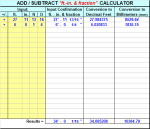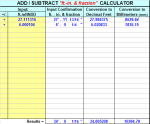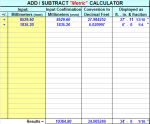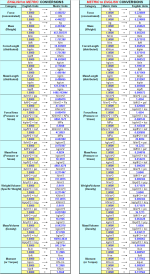CONVCALC.xls

Description
"CONVCALC" is a spreadsheet program written in MS-Excel for the purpose of facilitating the adding and subtracting of numbers (dimensions) represented in English "ft.-in. & fraction" format, as well as converting those numbers to Metric (millimeter) equivalents. Also included are some miscellaneous English/Metric conversions pertaining specifically to mass, force, and unit length or area.
This program is a workbook consisting of five (5) worksheets, described as follows:
- Doc
- ft-in-frac Calculator (Ver. 1) - Calculator to Add and Subtract feet, inches, and fractions (Version 1)
- ft-in-frac Calculator (Ver. 2) - Calculator to Add and Subtract feet, inches, and fractions (Version 2)
- Metric Conversion Calculator - Calculator to Add/Subtract in Metric with English Conversions
- Misc. Conversions - Miscellaneous English/Metric Conversions
1. The "ft-in-frac Calculator (Ver. 1)" and "ft-in-frac Calculator (Ver. 2)" worksheets are two different input format versions of the same tool to add and/or subtract up to twenty (20) entries. In each of these two (2) worksheets, the input is first displayed for confirmation. Then, it is converted into decimal feet, and finally converted into a Metric equivalent in terms of millimeters. Arithmetic results are totalled and displayed at the bottom.
2. The "ft-in-frac Calculator (Ver.1)" worksheet has a required input format as follows:
ft = whole feet
in = whole inches (0 to 11 max.)
N = numerator of fraction (if applicable)
D = denominator of fraction (if applicable)
Note: Do not input a numerator value (N) >= denominator value (D). However, 0/0 may be input for no fraction value, or clear cells with "Clear Contents" (do not use "Space Bar").
3. The "ft-in-frac Calculator (Ver. 2)" worksheet has a required input format as follows:
ft.inNNDD
where: ft = whole feet
in = whole inches (2 digits required, if applicable)
NN = numerator of fraction (2 digits required, if applicable)
DD = denominator of fraction (2 digits required, if applicable)
Examples of input: 4'-7 1/8" is input as 4.070108
10'-11 13/16 is input as 10.111316
2'-1" is input as 2.01 (trailing zeros not required)
Note: This version is included due to the similarity of form and function to past programs developed for HP handheld calculators.
4. In the "Metric Conversion Calculator" worksheet, the input in millimeters is converted into decimal feet and then displayed in feet, inch, and fraction format. Arithmetic results for adding and/or subrtracting up to twenty (20) entries are totalled and displayed at the bottom.
5. In the "Metric Conversion Calculator" worksheet, the user can input the degree of accuracy to be used in conversion from millimeters to feet, inch, and fraction format. Either 1/16" or 1/32" may be selected.
6. All three (3) "Calculator" worksheets require the user to select the arithmetic operator to be used for each entry, either addition (+) or subtraction (-). Note: if left blank, the program assumes addition (+).
7. This program contains numerous “comment boxes” which contain a wide variety of information including explanations of input or output items, equations used, data tables, etc. (Note: presence of a “comment box” is denoted by a “red triangle” in the upper right-hand corner of a cell. Merely move the mouse pointer to the desired cell to view the contents of that particular "comment box".)
Calculation Reference
Conversion Factors
Engineering Conversions
Systems of Units
Calculation Preview
Full download access to any calculation is available to users with a paid or awarded subscription (XLC Pro).
Subscriptions are free to contributors to the site, alternatively they can be purchased.
Click here for information on subscriptions.
Comments: 3
×
atomanovich
18 years ago
Duncan I have just updated all the file icons so that users can easily differentiate between native XL files and those which use the XLC add-in. [For example take a look at the maths folder where there are quite a few native XL file and some XLC files.](/404/)
18 years ago
The majority do Duncan but there are some that do not. In particular Spreadsheets written by Alex Tomanovich tend not to display equations but they are so useful I wanted to include them in the repository. Try some of the other examples not written by Alex if you want to see how XLC works.
Cheers
John
Cheers
John




